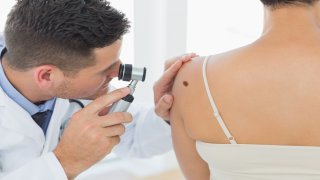

The following content is created in partnership with Palomar Health. It does not reflect the work or opinions of the NBC San Diego editorial staff. Click here to learn more about Palomar Health.
Few would deny the healing powers of the great outdoors, and many of us feel inclined to step outside for our mental health. But as temperatures rise and our outdoor activities become more frequent, our skin becomes increasingly exposed to the sun. While sunlight is an important source of vitamin D and other essential benefits, unchecked exposure means heightened risk of skin damage or even skin cancer down the line.
Skin cancer is the most common cancer in the US and across the world. Over 9,500 people in the US are diagnosed with skin cancer every day, and approximately 1 in 5 Americans will develop some form of skin cancer by age 70. Fortunately, there are a few simple ways to prevent most skin cancers and spot them early if they do occur. Keeping the following risk factors, warning signs and preventative measures in mind will help you maintain long-term skin health.
Get San Diego local news, weather forecasts, sports and lifestyle stories to your inbox. Sign up for NBC San Diego newsletters.
Everyday habits that can prevent skin cancer
The primary risk factor for developing skin cancer is sun exposure. All types of skin cancer, including melanoma and non-melanoma, are associated with UV radiation. Five or more sunburns during a lifetime, or even just one blistering sunburn during childhood or adolescence doubles the possibility of developing melanoma later in life.
Consequently, the most important and effective preventative measure is the use of sunblock. Regular daily use of water-resistant broad-spectrum sunscreen of SPF 30 or higher, especially before extended outdoor activities, reduces the risk of some skin cancers by 40 to 50 percent. Generally, it’s beneficial to minimize sun exposure and seek shade between 10 am and 4 pm when UV rays are typically strongest. It is also advisable to avoid indoor tanning - a particularly dangerous habit—at all costs. Compared to the sun at its peak intensity, indoor tanning devices emit 10 to 15 times the amount of UV radiation.
In addition to following these measures to protect your skin, regular self-examinations from head to toe are critical, as well as the only way to ensure the early detection of irregular moles or skin growth. Doctors recommend scheduling a professional skin examination with your physician once a year and also to check your sun-exposed and non-exposed skin for changes once a month.
Keeping an eye on the warning signs
To detect and treat melanoma and nonmelanoma skin cancers early or prevent them from developing altogether, it is crucial that you keep track of your existing moles and any irregular changes, new moles, sores, or itching.
The best way to administer a skin self-exam is following the ABCDEs of Melanoma:
- Asymmetry: Melanomas are usually asymmetrical, making them visibly distinguishable from regular round or oval moles. To check for symmetry, you can draw a line through the middle of your mole and see if the two halves match.
- Borders: While common moles have smooth or even borders, melanomas tend to be uneven with notched or scalloped edges.
- Color: Moles are typically a single shade of brown while melanomas can appear in different shades of brown, tan or black and might include red, white, and blue patterns as the cancer cells grow.
- Diameter: If a skin growth or mole develops on your skin that is the size of a pencil eraser or larger (1/4-inch diameter or more than 6 mm) it should be taken as a warning sign.
- Evolution: Look out for any changes in terms of size, shape, color, or elevation, as well as new symptoms, like itching, crusting, or bleeding of an existing mole.
Something doesn’t seem quite right—how, and when, do you treat skin cancer?
A dermatologist visit should be scheduled immediately upon the detection of any warning signs or changes in the skin, but there’s good news: the five-year survival rate for melanomas that are detected early is 99 percent, especially when the cancer hasn’t yet spread to other organs.
Once a skin cancer is diagnosed, treatment varies, depending on the type, size, depth, and location of the cell growth, as well as the patient’s medical history. The most common treatment methods include:
- Freezing/Cryosurgery: Cancerous cells are removed by applying liquid nitrogen to the growth on your skin.
- Surgery: There are different types of surgeries that remove cancerous cells. In some cases, especially for invasive melanomas that have spread to neighboring skin tissue, a surrounding margin of healthy tissue is removed as well.
- Medication or radiation therapy: If a skin cancer can’t be removed with surgical treatment, or if it has spread to other parts of the body, radiation therapy or chemotherapy can be used to destroy the cancerous cells.
Understanding who is most at risk
Although sun exposure and sunburns are the main risk factors for developing skin cancer, there are certain characteristics that predispose certain individuals. People with freckles, lighter natural skin tones, or blonde or red hair are generally more vulnerable to UV radiation. But genetics are not the only potential risk factor. Because immunity decreases with age, elder populations are more susceptible to UV.
Regardless of your personal risk factors for skin cancer, it is important to follow these simple preventative measures—it is the only way to ensure the long-term health of your skin and limit your risk for developing skin cancer.
Palomar Health’s world-class physicians and nurses will help you prioritize your skin health and are here for you in case you do need treatment. Click here to learn more about Palomar Health.

